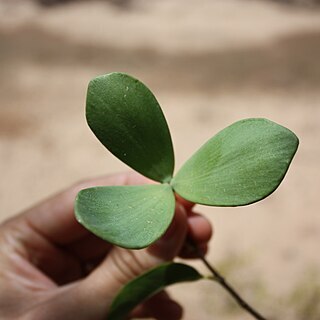Liana, or scandent rarely erect shrubs. Stipules interpetiolar or sometimes ± intrapetiolar. Leaves decussate. Inflorescences axillary, dichotomously cymose. Calyx deeply 5-lobed. Petals 5, usually rather thick, subcoriaceous to coriaceous when dry, subvalvate or the margins slightly overlapping, usually acuminate, entire, puberulous on the outer surface, sometimes glabrescent. Disk extrastaminal, fleshy, simple and annular-pulvinate, rarely double with the outer part cupular and the inner part forming a kind of receptacular androgynophore (in extra-Mal. spp.). Stamens 3, inserted at the base of the free part of the pistil; filaments linear, reflexed at anthesis; anthers transversely dehiscent, extrorse. Ovary half-immersed, sometimes superior, 3-celled; style distinct, slender; stigma obscure. Ovules 4-12 in each cell. Fruit capsular, consisting of 3 separate, divergent, dorsoventrally flattened 'follicles' each dehiscing along an inconspicuous median suture into 2 navicular valves. Seeds usually with a basal wing, the wing usually membranous, with 1 submedian (raphe) and 1 marginal 'nerve'; endosperm 0; cotyledons completely, sometimes only partly united.
Woody lianas, puberulent or glabrescent, lenticellate, internodes slightly enlarged. Leaves opposite or subopposite, entire or crenulate. Inflorescences axillary or terminal, cymose. Flowers bisexual, 5-merous. Disk fleshy, cupular, sometimes arranged in rings, extrastaminal. Stamens 3; filaments tonguelike; anthers transversely dehiscent, extrorse. Ovary weakly triangular, partially or wholly concealed in disk, 3-locular; ovules 4-8 per locule. Fruits 1-3-fascicled capsules; capsule transversely flattened, leathery, loculicidally dehiscent. Seeds 4-8, with membranous basal wings, exalbuminous.

